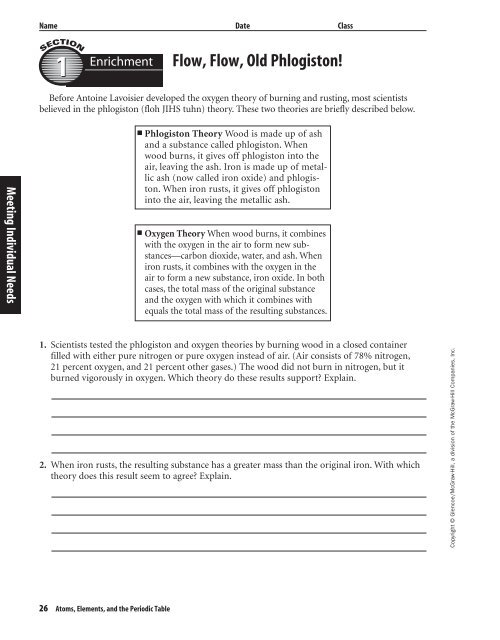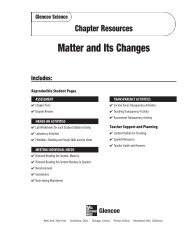Atoms, Elements, and the Periodic Table - Learning Services Home
Atoms, Elements, and the Periodic Table - Learning Services Home
Atoms, Elements, and the Periodic Table - Learning Services Home
You also want an ePaper? Increase the reach of your titles
YUMPU automatically turns print PDFs into web optimized ePapers that Google loves.
Name Date Class1EnrichmentFlow, Flow, Old Phlogiston!Before Antoine Lavoisier developed <strong>the</strong> oxygen <strong>the</strong>ory of burning <strong>and</strong> rusting, most scientistsbelieved in <strong>the</strong> phlogiston (floh JIHS tuhn) <strong>the</strong>ory. These two <strong>the</strong>ories are briefly described below.Meeting Individual Needs■ Phlogiston Theory Wood is made up of ash<strong>and</strong> a substance called phlogiston. Whenwood burns, it gives off phlogiston into <strong>the</strong>air, leaving <strong>the</strong> ash. Iron is made up of metallicash (now called iron oxide) <strong>and</strong> phlogiston.When iron rusts, it gives off phlogistoninto <strong>the</strong> air, leaving <strong>the</strong> metallic ash.■ Oxygen Theory When wood burns, it combineswith <strong>the</strong> oxygen in <strong>the</strong> air to form new substances—carbondioxide, water, <strong>and</strong> ash. Wheniron rusts, it combines with <strong>the</strong> oxygen in <strong>the</strong>air to form a new substance, iron oxide. In bothcases, <strong>the</strong> total mass of <strong>the</strong> original substance<strong>and</strong> <strong>the</strong> oxygen with which it combines wi<strong>the</strong>quals <strong>the</strong> total mass of <strong>the</strong> resulting substances.1. Scientists tested <strong>the</strong> phlogiston <strong>and</strong> oxygen <strong>the</strong>ories by burning wood in a closed containerfilled with ei<strong>the</strong>r pure nitrogen or pure oxygen instead of air. (Air consists of 78% nitrogen,21 percent oxygen, <strong>and</strong> 21 percent o<strong>the</strong>r gases.) The wood did not burn in nitrogen, but itburned vigorously in oxygen. Which <strong>the</strong>ory do <strong>the</strong>se results support? Explain.2. When iron rusts, <strong>the</strong> resulting substance has a greater mass than <strong>the</strong> original iron. With which<strong>the</strong>ory does this result seem to agree? Explain.Copyright © Glencoe/McGraw-Hill, a division of <strong>the</strong> McGraw-Hill Companies, Inc.26 <strong>Atoms</strong>, <strong>Elements</strong>, <strong>and</strong> <strong>the</strong> <strong>Periodic</strong> <strong>Table</strong>














